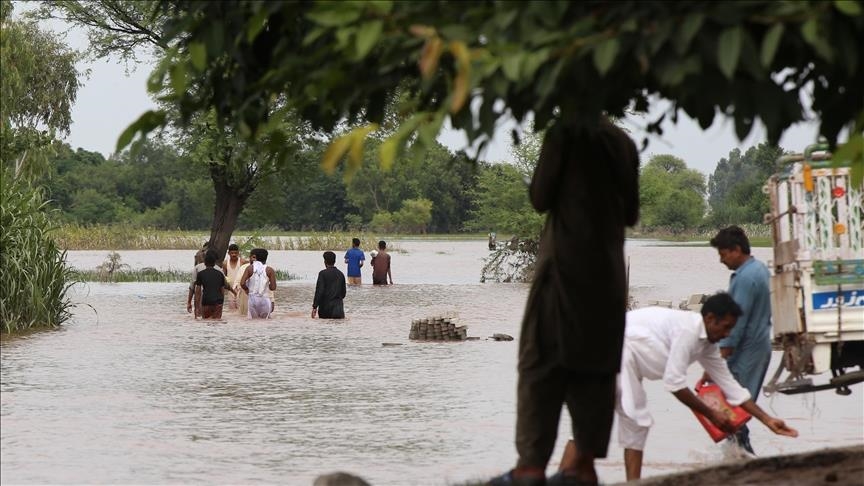Deadly floods risk triggering mass migration in Pakistan
Torrential rains and deluges have killed over 920 people, destroyed thousands of homes, and inundated stretches of farmlands in Pakistan since late June

- Experts fear floods could force as many as 1 million people to migrate to big cities, adding mounting pressure to urban infrastructure
- Officials downplay chances of large migration, saying the Pakistani government is set to announce a ‘massive rehabilitation package’
KARACHI, Pakistan
Weeks of torrential monsoon rains have unleashed catastrophic floods across Pakistan, killing more than 920 people, displacing nearly 2 million, submerging vast stretches of farmland, and sweeping away homes, schools and livestock.
The disaster could now trigger one of the country’s largest internal migrations since the devastating 2010 floods, aid agencies and local experts warn.
“Migration has already started in several areas as unprecedented rains and floods have left nothing behind for millions of people,” Shaukat Ali Chadhar, president of the Federation of Pakistan Chambers of Agriculture, told Anadolu.
Chadhar said the ongoing deluges have already affected around 10 million people dependent on agriculture across the country, mainly in northeastern Punjab province, the nation’s food basket.
“A multi-pronged combination of rains and floods has affected the farmers in many ways, destroying stored and standing crops, agricultural lands and livestock,” he explained, saying it could take up to 18 months for the land to become cultivable again.
“This gloomy scenario has left no choice for them but to migrate to the big cities to make a living,” Chadhar said, warning that as many as 1 million migrants could make the move.
Climate disaster compounded by human factors
The International Federation of Red Cross and Red Crescent Societies (IFRC) warned last Friday that Pakistan is facing one of its worst monsoon seasons in recent memory.
According to the National Disaster Management Authority (NDMA), at least 922 people have been killed and 1,047 injured since late June, while more than 10,000 homes have been partially or completely destroyed, mainly in Punjab and the northwestern Khyber Pakhtunkhwa (KP) province.
In late August, India – also battered by heavy rains – opened the gates of major dams on rivers shared under the Indus Waters Treaty, cautioning Pakistan that the releases could swell downstream floods. The added discharges pushed Punjab’s water levels even higher.
For the first time in Pakistan’s 78-year history, three eastern rivers – the Sutlej, Jhelum and Chenab – are simultaneously at “exceptionally” high flood levels, according to local authorities.
In Gilgit-Baltistan, sudden glacial lake outburst floods added another layer of devastation, tearing through remote valleys and destroying homes, water systems and power lines. These floods occur when rains or rising temperatures cause mountain lakes to burst, releasing torrents of water and debris with little warning.
The UN says climate change is accelerating glacial melt across the Himalaya and Hindu Kush ranges, creating more unstable lakes and heightening the risk of such disasters.
“Unpredictable and intense weather patterns, shrinking agriculture, sea erosion, unemployment, and lingering dry spells have caused widespread migration within Pakistan in the past decade,” Hafiz Wasi Mohammad Khan, a member of the state-run Punjab Agriculture Research Board, told Anadolu. “We fear that this process would be further accelerated by the latest floods.”
He estimated that although temporary migration will be higher, around 25% of the displaced people may never be able to return to their homes.
Earlier this year, the Climate Risk Index ranked Pakistan as the country most affected by climate change in 2022.
Experts also point to human-driven vulnerabilities such as unchecked land grabs and illegal constructions along natural drainage paths, which the government has vowed to address.
“Pakistan stands where it was in 2010 in terms of handling floods,” Khan said. “I suspect we will be discussing the same situation next year.”
Government planning ‘massive rehabilitation package’
In 2010, more than 2 million people were displaced by floods that inundated one-fifth of the country. Of those, 70% permanently settled in big cities because of the destruction of their homes and farmlands, according to Pakistan’s Climate Change Ministry.
Khan warned that another wave of mass migration to already-overcrowded cities would not only add to their strained infrastructure, but also fuel crime and deepen poverty.
“An enormous challenge is ahead in terms of rehabilitation and food security. The affected families have lost everything – their homes, lands, livestock and piled up stocks,” he said, adding that farmers urgently need cash inputs to procure seeds and other agricultural supplies.
He noted that many communities, especially downstream, have learned from recurring floods over the past two decades. In some cases, they even view them as opportunities, as floods can regenerate land and replenish underground water levels.
Chadhar called for the establishment of a “special agriculture fund” to help farmers, in addition to writing off their loans and utility bills, saying the government cannot handle the challenge of rehabilitation alone.
Meanwhile, Farid Abdulkadir Aiywar, IFRC head of delegation for Pakistan, urged the international community not to overlook the unfolding tragedy that is “quietly but relentlessly” devastating communities across the country.
“The crisis is far from over,” he told reporters Friday. “Entire communities remain underwater, families have lost everything, and access to safe water and health care is becoming more urgent by the day.”
Irfan Ali Kathia, director general of the Punjab Disaster Management Authority, however, downplayed the chances of a large migration toward urban centers.
“This time, there will be no mass migration by flood affectees as the government is set to announce a massive rehabilitation package for them, which will cover everything – from their crops and land losses to home destruction,” Kathia told Anadolu.
Anadolu Agency website contains only a portion of the news stories offered to subscribers in the AA News Broadcasting System (HAS), and in summarized form. Please contact us for subscription options.







